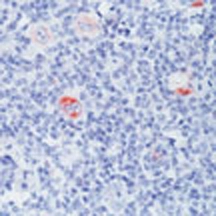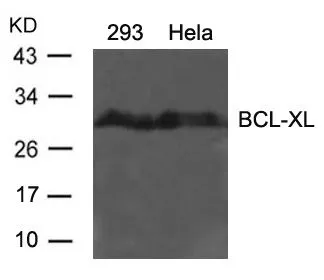Bcl-X antibody
GTX105661
ApplicationsImmunoFluorescence, ImmunoPrecipitation, Western Blot, ImmunoCytoChemistry, ImmunoHistoChemistry, ImmunoHistoChemistry Paraffin
Product group Antibodies
TargetBCL2L1
Overview
- SupplierGeneTex
- Product NameBcl-X antibody
- Delivery Days Customer9
- Application Supplier NoteWB: 1:500-1:3000. ICC/IF: 1:100-1:1000. IHC-P: 1:100-1:1000. IP: 1:100-1:500. *Optimal dilutions/concentrations should be determined by the researcher.Not tested in other applications.
- ApplicationsImmunoFluorescence, ImmunoPrecipitation, Western Blot, ImmunoCytoChemistry, ImmunoHistoChemistry, ImmunoHistoChemistry Paraffin
- CertificationResearch Use Only
- ClonalityPolyclonal
- Concentration0.45 mg/ml
- ConjugateUnconjugated
- Gene ID598
- Target nameBCL2L1
- Target descriptionBCL2 like 1
- Target synonymsBCL-XL/S, BCL2L, BCLX, Bcl-X, PPP1R52, bcl-2-like protein 1, apoptosis regulator Bcl-X, protein phosphatase 1, regulatory subunit 52
- HostRabbit
- IsotypeIgG
- Protein IDQ07817
- Protein NameBcl-2-like protein 1
- Scientific DescriptionThe protein encoded by this gene belongs to the BCL-2 protein family. BCL-2 family members form hetero- or homodimers and act as anti- or pro-apoptotic regulators that are involved in a wide variety of cellular activities. The proteins encoded by this gene are located at the outer mitochondrial membrane, and have been shown to regulate outer mitochondrial membrane channel (VDAC) opening. VDAC regulates mitochondrial membrane potential, and thus controls the production of reactive oxygen species and release of cytochrome C by mitochondria, both of which are the potent inducers of cell apoptosis. Two alternatively spliced transcript variants, which encode distinct isoforms, have been reported. The longer isoform acts as an apoptotic inhibitor and the shorter form acts as an apoptotic activator. [provided by RefSeq]
- Storage Instruction-20°C or -80°C,2°C to 8°C
- UNSPSC12352203
References
- Lee CW, Huang CC, Chi MC, et al. Naringenin Induces ROS-Mediated ER Stress, Autophagy, and Apoptosis in Human Osteosarcoma Cell Lines. Molecules. 2022,27(2). doi: 10.3390/molecules27020373Read this paper
- Wang WJ, Lai HY, Zhang F, et al. MCL1 participates in leptin-promoted mitochondrial fusion and contributes to drug resistance in gallbladder cancer. JCI Insight. 2021,6(15). doi: 10.1172/jci.insight.135438Read this paper
- Chao YC, Lee KY, Wu SM, et al. Melatonin Downregulates PD-L1 Expression and Modulates Tumor Immunity in KRAS-Mutant Non-Small Cell Lung Cancer. Int J Mol Sci. 2021,22(11). doi: 10.3390/ijms22115649Read this paper
- Lee CW, Chi MC, Chang TM, et al. Artocarpin induces cell apoptosis in human osteosarcoma cells through endoplasmic reticulum stress and reactive oxygen species. J Cell Physiol. 2019,234(8):13157-13168. doi: 10.1002/jcp.27986Read this paper
- Lee CF, Chiang NN, Lu YH, et al. Benzyl isothiocyanate (BITC) triggers mitochondria-mediated apoptotic machinery in human cisplatin-resistant oral cancer CAR cells. Biomedicine (Taipei). 2018,8(3):15. doi: 10.1051/bmdcn/2018080315Read this paper
- Fu K, Sun X, Wier EM, et al. Sam68/KHDRBS1-dependent NF-κB activation confers radioprotection to the colon epithelium in γ-irradiated mice. Elife. 2016,5:pii: e21957. doi: 10.7554/eLife.21957.Read this paper
- Chen PH, Chang CK, Shih CM, et al. The miR-204-3p-targeted IGFBP2 pathway is involved in xanthohumol-induced glioma cell apoptotic death. Neuropharmacology. 2016,110(Pt A):362-375. doi: 10.1016/j.neuropharm.2016.07.038Read this paper
- Chen MF, Huang SJ, Huang CC, et al. Saikosaponin d induces cell death through caspase-3-dependent, caspase-3-independent and mitochondrial pathways in mammalian hepatic stellate cells. BMC Cancer. 2016,16:532. doi: 10.1186/s12885-016-2599-0Read this paper
- Fu K, Sun X, Wier EM, et al. Sam68/KHDRBS1 is critical for colon tumorigenesis by regulating genotoxic stress-induced NF-κB activation. Elife. 2016,5:pii: e15018. doi: 10.7554/eLife.15018.Read this paper
- Huang YT, Chen YY, Lai YH, et al. Resveratrol alleviates the cytotoxicity induced by the radiocontrast agent, ioxitalamate, by reducing the production of reactive oxygen species in HK-2 human renal proximal tubule epithelial cells in vitro. Int J Mol Med. 2016,37(1):83-91. doi: 10.3892/ijmm.2015.2404Read this paper



![WB analysis of various samples using GTX01535 Bcl-XL antibody [GT1227]. Dilution : 1:1000 Loading : 25 microg](https://www.genetex.com/upload/website/prouct_img/normal/GTX01535/GTX01535_20200508_WB_w_23053121_834.webp)


